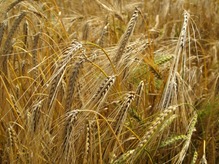The 10,000-Year-Old Problem: Annual Food Plants
Article from THE LAND INSTITUTE, June 2010
 The world’s farms, heavily reliant on non-renewable resources, are turning out more food than ever in history. At the same time, agriculture unintentionally but tragically worsens the global ecological crisis. These two faces of agriculture—productivity and destructiveness—do not arise from the conscious decisions of fuel, fertilizer, or pesticide salespeople, or of farmers, government officials or grocery shoppers. They are inherent in the way humans have practiced agriculture for 10,000 years. Recently, chemicals and other non-renewable resources have only exacerbated the problem.
The world’s farms, heavily reliant on non-renewable resources, are turning out more food than ever in history. At the same time, agriculture unintentionally but tragically worsens the global ecological crisis. These two faces of agriculture—productivity and destructiveness—do not arise from the conscious decisions of fuel, fertilizer, or pesticide salespeople, or of farmers, government officials or grocery shoppers. They are inherent in the way humans have practiced agriculture for 10,000 years. Recently, chemicals and other non-renewable resources have only exacerbated the problem.
The problem of agriculture rather than problems in agriculture
Since its very first days, agriculture has rested on a foundation of annual plants—grains and legumes supply over two-thirds of human food needs that are grown from seed every year and harvested for their seed. That requires disturbance of the soil resource, either by the ancient practice of tilling or by chemical treatment. Tillage can be done without causing great harm when it’s on a very small scale. Nearly everywhere, civilizations that have practiced tillage beyond the level of the kitchen garden have suffered, often catastrophically, from soil erosion.
Compounding the problem in recent decades is the widespread use of herbicides to supplement or replace tillage. As a result, these herbicides are found in the tissues of most of our nation’s children.
Today, satellite images of the planet make for grim viewing, with vast swaths of entire continents having been scoured of their deep-rooted, year-round perennial vegetation, leaving the soil uncovered for months at a time, susceptible to erosion from wind and water. Even during the growing season when the landscape is green, shallow-rooted annual crops fail to manage water and nutrients as did their perennial predecessors. The destruction of deep, massive perennial root systems through tillage has wrecked entire underground ecosystems, subtracting from the soil much of what makes it soil.
It’s a problem older than history. Agriculture has always depended largely on annual grass and legume species that were domesticated by humans between 5,000 and 10,000 years ago. Today, we have the scientific knowledge, data and techniques—fruits of a civilization made possible by agriculture—that demonstrate not only the damage done by annual cropping systems but more importantly, the opportunity to correct the wrong turn our species took.
We can’t go back to the crossroads where our ancestors took that wrong turn, or to a Golden Age of folk agriculture that never existed. But through a wholly new way of farming, we can accomplish something never before done: to make conservation a consequence of, not an alternative to, food production. We can now envision an agriculture in which we bring the ecological processes embodied within wild biodiversity to the farm, rather than forcing agriculture to relentlessly nick away wild ecosystems.
Diverse perennial solutions
Since 1976, The Land Institute has been developing the big idea that humans can make conservation a consequence of production—in any region on the planet—if we use as our standard the ecosystems that existed in that region before it was utilized by humans. In doing so, we need not sacrifice the ability to feed ourselves.
Chris Field, National Academy of Sciences member, reported in Science (2001) that natural ecosystems (and on land, that almost always means mixtures of perennial species) do better than agriculture and other human-managed systems in converting sunlight into living tissue. The plants that anchor those ecosystems have extensive, long-lived root systems with diverse architectures; they have a longer growing season; and their species diversity protects against epidemics and the vagaries of weather. As a result, they can produce, year in and year out, more biomass per acre than agricultural systems without requiring a subsidy of fossil fuels and other inputs and without degrading soil and water. [Read rest of article]


